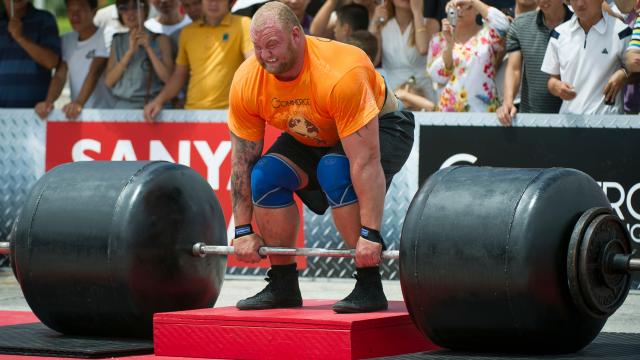I’ve had three different lower-back injuries in my life, all thanks to crappy deadlift form. It wasn’t until a few years ago, after joining a powerlifting gym, that I finally learned what might be the single biggest contributor to my nagging back pain: The act of touch-and-go deadlifts and only lightly grazing the floor between each rep.
If you’re ever perused Reddit r/fitness threads, you’ll find that fully resetting between reps is the only acceptable way to approach a deadlift; and it’s true, unlike touch-and-go’s, you stand to benefit a whole lot more from taking a short breather while deadlifting.
Fully resetting helps you gain strength off the ground
As Avi Silverberg writes on PowerliftingTechnique.com, the very bottom range of a deadlift — picking the barbell off the ground — requires a ton of strength from your quads and spinal erectors (which run the length of your back). By fully resetting between reps, you’re requiring the maximal amount of strength of these two areas to pick up the weight with each rep.
If you’re insisting on touch-and-go deadlifts, however, there’s a good chance you’re “bouncing” your reps, or assisting the bottom portion of a deadlift by bouncing the weight off the floor. You’re using the momentum of the bounce and not necessarily using your strength.
“If you’re constantly used to getting a ‘bounce’ off the bottom, there will be no bounce available when pulling a single rep,” Silverberg writes, which becomes a problem for competitive powerlifters or others focused on boosting their one-rep maxes.
By training with reset deadlifts, you’re better prepared to get off the ground (and from personal experience, I can say that it’s often the hardest part of the lift).
Resets are necessary for form and to avoid injury
Between reset reps, you can easily correct your form; during touch-and-go, you don’t have those moments to course-correct, according to K. Aleisha Fetters, a personal and online trainer. By using touch-and-go, your form is at risk if you lose tension, or tightness, between each rep.
“If you’re losing tension on the way down, and are progressively doing that with each rep, by the time you’re on your eighth rep, your form can be totally deteriorated,” she said over the phone.
“Resetting between every rep can make sure you have maximal tension, you’re in proper form, and every rep is coming from the best foundation set-up. In every exercise, the priority should be on quality over quantity and that’s what resetting helps with.”
In other words, there’s a greater risk of injury via touch-and-go deadlifts (and a 2018 study found that your posterior chain, the muscles on the backside of your body like hamstrings and glutes, may be at greater risk during a bounce deadlift versus a fully reset lift).
Pausing for a few seconds is ideal while resetting
Is there ever a situation in which touch-and-go might serve a purpose? Yes, as it turns out, you could feasibly use them to lift less weight for more reps for some extra cardio.
“It can be used for developing speed and power,” Kenny Mahadeo, a personal trainer, said over the phone. “But you need to pay more attention to technique.”
According to Fetters, however, resetting for at least one to two seconds is likely key if you plan on raising your one-rep max, safely.
“It doesn’t have to be huge,” she said. “Just make sure you’re in the right alignment, your spine is good, [you’re] pinning those lats back, and going into the next rep with purpose. With the deadlift, a lot of people are churning them out, but you have to dial in on form and give yourself some time.”
If you’re extra ambitious, you can even try deficit deadlifts, which require standing on an elevated platform and can serve as practice getting the weight off the ground, though it’s not for everyone.
And if you’re having to lower the weight to nail those fully reset reps, that’s OK, too — it’s all in the name of form, after all.

Comments